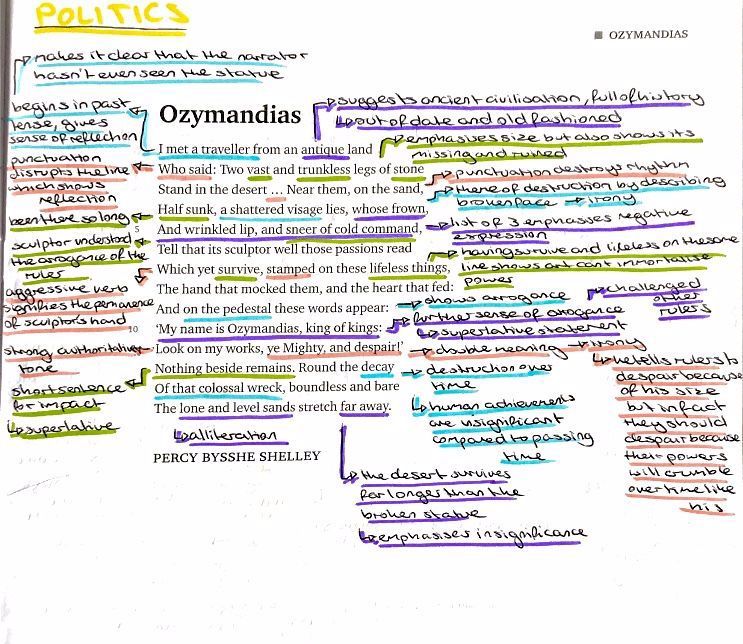
Percy Bysshe Shelley’s Ozymandias: A Poetic Analysis
Percy Bysshe Shelley’s iconic sonnet, "Ozymandias," stands as a haunting meditation on the fleeting nature of power and the corrosive touch of time. Through its evocative imagery and philosophical depth, the poem invites us to contemplate the vanity of human ambition and the ultimate triumph of nature.
Writing Styles Suitable for "Ozymandias" Analysis
The themes of "Ozymandias" lend themselves to a variety of writing styles, including:
- Dramatic Monologue: The poem can be interpreted as a dramatic monologue spoken by the traveler who encounters the ruined statue. This approach allows for a vivid portrayal of the speaker’s emotions and insights.
- Descriptive Poetry: The poem’s vivid imagery of the desert landscape and the shattered statue provides ample material for descriptive poetry. This style captures the physical details and conveys the emotional atmosphere of the scene.
- Reflective Poetry: "Ozymandias" encourages deep reflection on themes such as power, ambition, and mortality. Reflective poetry allows poets to explore the philosophical implications of the poem and draw personal connections to its message.
Poetic Explorations of "Ozymandias"
Sonnet to Time’s Tyranny
In barren lands where echoes roam,
A shattered statue stands alone.
Ozymandias, once so grand,
Now lies a relic on the sand.
His haughty words, once etched in stone,
"Look on my works, ye mighty, and despair,"
Now mocking whispers, overthrown,
By Time’s relentless, crushing air.
The desert’s breath, a cruel caress,
Erodes his image, claims his pride.
The sun above, nature’s duress,
Burns his legacy, naught to hide.
The Broken Colossus
Once a colossus, towering high,
Now shattered fragments strewn across the plain.
Ozymandias’ dreams, a dying sigh,
Echoes lost in Time’s dismissive reign.
His statue, once a symbol of command,
Lies shattered, mocked by fate’s cruel hand.
The desert sands, a relentless tide,
Swallow his glories, leaving naught to hide.
His words, once etched in regal might,
"Look on my works, ye mighty, and despair,"
Now whispered softly by the night,
A testament to Time’s unyielding snare.
The Sands of Time
Through scorching sands and barren waste,
The traveler wanders, lone and graced.
Ozymandias’ legacy, now erased,
A broken idol, time has chased.
Half sunk, the shattered statue stands,
A relic of a power that once planned.
The desert’s embrace, a solemn hand,
Claims his throne, reclaims the land.
The sands of time, like grains of glass,
Grind down his pride, obliterate his mass.
His words, once bold, now lost and dim,
Lost to the echoes of Time’s relentless hymn.
How to Write Poetry About "Ozymandias"
- Read the poem carefully and analyze its themes: Consider the poem’s message about power, ambition, and mortality.
- Choose a writing style that complements the themes: Reflect on the various styles discussed above and select one that best suits your intended message.
- Use vivid imagery and descriptive language: Create a vivid picture of the desert landscape and the ruined statue to engage the reader’s senses.
- Explore the poem’s philosophical implications: Draw connections between the poem’s themes and your own experiences or observations.
- Craft a concise and evocative poem: Sonnets are a popular choice for analyzing "Ozymandias," but poets can also experiment with other forms.
Reading Tips for Poetry
- Read the poem aloud to appreciate its rhythm and sound.
- Annotate the poem to identify key themes and literary devices.
- Research the poet’s background to understand their motivations and influences.
- Discuss the poem with others to gain different perspectives.
- Explore different interpretations of the poem and consider the evidence provided by the text.
Conclusion
Percy Bysshe Shelley’s "Ozymandias" remains a timeless masterpiece that invites poets to explore the complex and enduring themes of power, ambition, and mortality. By delving into the poem’s imagery, symbolism, and philosophical depth, we gain insights into the nature of human striving and the transformative power of time. May this poetic tribute inspire you to engage with this iconic sonnet and discover your own unique interpretations.
Remember: Avoid plagiarizing the work of others. Always give credit to the original author when sharing poetry and ideas. Let us foster a vibrant literary community where creativity and respect for authorship thrive.
